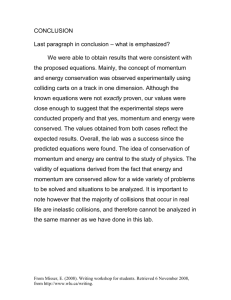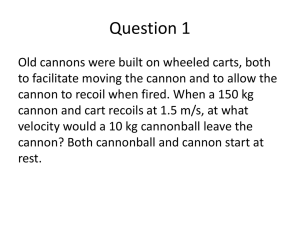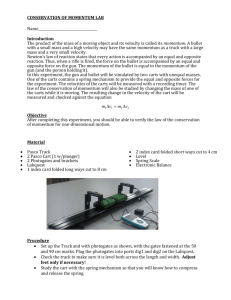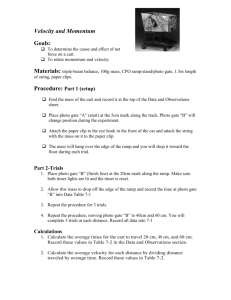Momentum Conservation
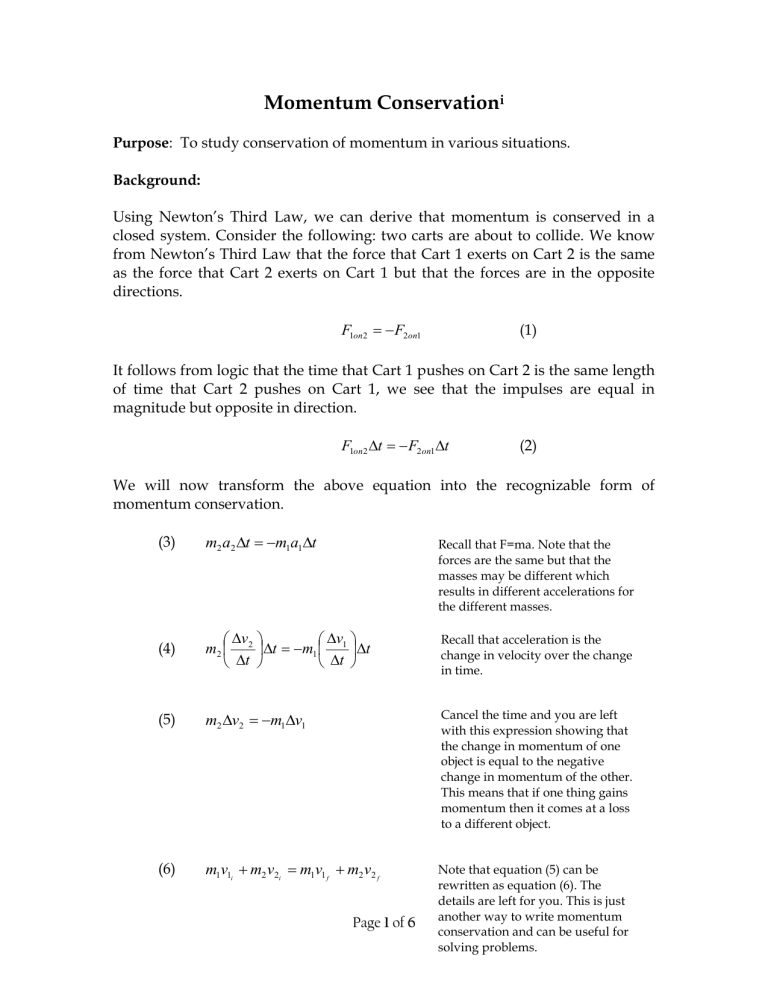
Momentum Conservation
i
Purpose: To study conservation of momentum in various situations.
Background:
Using Newton’s Third Law, we can derive that momentum is conserved in a closed system. Consider the following: two carts are about to collide. We know from Newton’s Third Law that the force that Cart 1 exerts on Cart 2 is the same as the force that Cart 2 exerts on Cart 1 but that the forces are in the opposite directions.
F
1 on 2
F
2 on 1
(1)
It follows from logic that the time that Cart 1 pushes on Cart 2 is the same length of time that Cart 2 pushes on Cart 1, we see that the impulses are equal in magnitude but opposite in direction.
F
1 on 2
t
F
2 on 1
t
(2)
We will now transform the above equation into the recognizable form of momentum conservation.
(3) m
2 a
2
t
m
1 a
1
t Recall that F=ma. Note that the forces are the same but that the masses may be different which results in different accelerations for the different masses.
(4) m
2
v
2
t
t
m
1
v
1
t
t
Recall that acceleration is the change in velocity over the change in time.
(5) m
2
v
2
m
1
v
1
Cancel the time and you are left with this expression showing that the change in momentum of one object is equal to the negative change in momentum of the other.
This means that if one thing gains momentum then it comes at a loss to a different object.
(6) m
1 v
1 i
m
2 v
2 i
m
1 v
1 f
m
2 v
2 f
Page 1 of 6
Note that equation (5) can be rewritten as equation (6). The details are left for you. This is just another way to write momentum conservation and can be useful for solving problems.
Materials: 2 motion sensors, 2 carts, track, metal bricks
Experimental Setup:
Cart 1 Cart 2
Procedure and Data Collection Background:
Set up the equipment such that there is a motion sensor at both ends of the track.
Check that the track is level by either using a bubble level or by releasing the cart from rest from several locations on the track and checking that the cart does not accelerate.
Turn on the Xplorer GLX. Plug in the motion sensors into ports 1 and 2. Be sure to take note as to which sensor is at which end of the track. Adjust the settings and make sure velocity is Visible for both motion sensors. It is best if the graphs are on the same physical graph, so once you take the first run of data; adjust the
Graph settings to View Two Graphs.
For each scenario, use your graph to find the velocity of each cart before and after the collision. For the velocity of the cart before the collision, use the cart’s velocity the instant before the collision. For the velocity of the cart after the collision, you can choose the velocity at any time. (Make sure that you read off the velocity for both carts for the same time.) Choose velocities for after the collision that are relatively close in time to the end of the collision. Record the velocities for before and after the collision for both carts.
Important: Note that the motion sensor reads whatever it is closest to, so the motion sensor on the right reads the cart on the right and the motion sensor on the left reads the cart on the left. In both cases, if the cart is moving away from the motion sensor, the sensor thinks that is a positive velocity for each of the carts. You will need to keep in mind that momentum is a vector and that the velocity given on the graph may be incorrect. For example, if cart 1 is on the left moving to the right toward cart 2, which is stationary, then the motion sensor on the left reads a positive velocity. If the carts stick and continue to move to the right, motion sensor one continues to read a positive velocity but motion sensor 2 reads a negative velocity because cart 2 is moving toward motion sensor two.
You will need to be very careful with your sign convention. Don’t just read the graph and write down the data – think carefully about whether the velocity is positive or negative. You may choose either direction (right or left) as positive, but you must be consistent.
Page 2 of 6
Part I: Elastic Collisions
1.
Determine the mass of each of your carts and the mass of one of the bricks.
Record this in Table 1.
2.
Place the carts on the track such that the magnets are facing each other.
Put Cart 1 near one of the motion sensors and Cart 2 a third or half way down the track. Press to collect data. Gently push Cart 1 toward Cart
2 making sure that the Velcro did not engage. Note that the Velcro can engage but the magnets push the carts apart anyway. Push the cart gently and
listen for the sound of Velcro.
3.
Using the graphs, determine the initial and final velocities for each cart as well as the time duration of the collision. Record your data in Table 1.
4.
Add a brick to one of the carts (is does not matter which one) and repeat the experiment. Record your results in Table 1.
Part II: Inelastic Collisions
5.
Now orient the carts such that the Velcro will stick when you push the carts together. Do the experiment for when the masses are equal and for when there is one brick in one of the carts. Record your results in Table 2.
Part III: Explosions
6.
Now orient the carts such that the plunger is pushed in and that the carts will fly apart when you hit the plunger with a brick. Do the experiment for when the masses are equal and for when there is one brick in one of the carts. Record your results in Table 3.
Page 3 of 6
Data:
Table 1: Elastic Collisions
Equal mass (no bricks on carts)
Mass, cart 1
Mass, cart 2
Initial velocity, cart 1
Initial velocity, cart 2
Initial momentum, cart 1
Initial momentum, cart 2
Total initial momentum
Final velocity, cart 1
Final velocity, cart 2
Final momentum, cart 1
Final momentum, cart 2
Total final momentum
Unequal mass (one cart with bricks)
Page 4 of 6
Table 2: Inelastic Collisions
Equal mass (no bricks on carts)
Mass, cart 1
Mass, cart 2
Initial velocity, cart 1
Initial velocity, cart 2
Initial momentum, cart 1
Initial momentum, cart 2
Total initial momentum
Final velocity, cart 1
Final velocity, cart 2
Final momentum, cart 1
Final momentum, cart 2
Total final momentum
Unequal mass (one cart with bricks)
Page 5 of 6
Table 3: Explosions
Equal mass (no bricks on carts)
Unequal mass (one cart with bricks)
Mass, cart 1
Mass, cart 2
Initial velocity, cart 1
Initial velocity, cart 2
Initial momentum, cart 1
Initial momentum, cart 2
Total initial momentum
Final velocity, cart 1
Final velocity, cart 2
Final momentum, cart 1
Final momentum, cart 2
Total final momentum
Analysis:
1.
Present your data tables neatly and include units and labels. If you use
Excel, please be sure to print the gridlines.
2.
What is your absolute and percent error for each scenario? Take the initial momentum to be the expected value. For the explosion, you will not be able to find the percent error so only find the absolute error.
3.
For each scenario, discuss whether or not momentum was conserved.
4.
Discuss sources of error. Be as quantitative as possible. That is, if you list a source of error, state how it changes your data. i
This lab meets Massachusetts State Frameworks for Introductory Physics standard 2.5
Page 6 of 6


